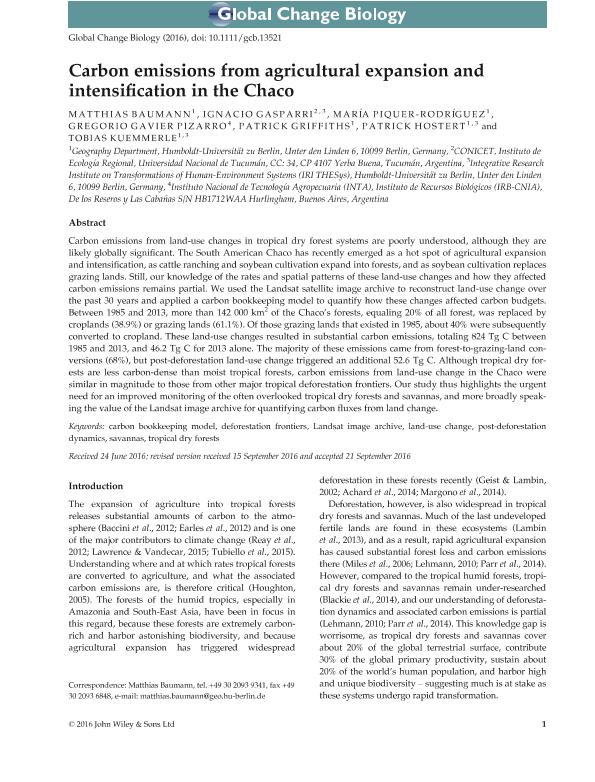Mostrar el registro sencillo del ítem
dc.contributor.author
Baumann, Matthias
dc.contributor.author
Gasparri, Nestor Ignacio

dc.contributor.author
Piquer-Rodríguez, María
dc.contributor.author
Gavier Pizarro, Gregorio

dc.contributor.author
Griffiths, Patrick
dc.contributor.author
Hostert, Patrick
dc.contributor.author
Kuemmerle, Tobias

dc.date.available
2018-11-28T13:46:42Z
dc.date.issued
2017-05
dc.identifier.citation
Baumann, Matthias; Gasparri, Nestor Ignacio; Piquer-Rodríguez, María; Gavier Pizarro, Gregorio; Griffiths, Patrick; et al.; Carbon emissions from agricultural expansion and intensification in the Chaco; Wiley Blackwell Publishing, Inc; Global Change Biology; 23; 5; 5-2017; 1902-1916
dc.identifier.issn
1354-1013
dc.identifier.uri
http://hdl.handle.net/11336/65401
dc.description.abstract
Carbon emissions from land-use changes in tropical dry forest systems are poorly understood, although they are likely globally significant. The South American Chaco has recently emerged as a hot spot of agricultural expansion and intensification, as cattle ranching and soybean cultivation expand into forests, and as soybean cultivation replaces grazing lands. Still, our knowledge of the rates and spatial patterns of these land-use changes and how they affected carbon emissions remains partial. We used the Landsat satellite image archive to reconstruct land-use change over the past 30 years and applied a carbon bookkeeping model to quantify how these changes affected carbon budgets. Between 1985 and 2013, more than 142 000 km2 of the Chaco's forests, equaling 20% of all forest, was replaced by croplands (38.9%) or grazing lands (61.1%). Of those grazing lands that existed in 1985, about 40% were subsequently converted to cropland. These land-use changes resulted in substantial carbon emissions, totaling 824 Tg C between 1985 and 2013, and 46.2 Tg C for 2013 alone. The majority of these emissions came from forest-to-grazing-land conversions (68%), but post-deforestation land-use change triggered an additional 52.6 Tg C. Although tropical dry forests are less carbon-dense than moist tropical forests, carbon emissions from land-use change in the Chaco were similar in magnitude to those from other major tropical deforestation frontiers. Our study thus highlights the urgent need for an improved monitoring of the often overlooked tropical dry forests and savannas, and more broadly speaking the value of the Landsat image archive for quantifying carbon fluxes from land change.
dc.format
application/pdf
dc.language.iso
eng
dc.publisher
Wiley Blackwell Publishing, Inc

dc.rights
info:eu-repo/semantics/openAccess
dc.rights.uri
https://creativecommons.org/licenses/by-nc-sa/2.5/ar/
dc.subject
Carbon Bookkeeping Model
dc.subject
Deforestation Frontiers
dc.subject
Land-Use Change
dc.subject
Landsat Image Archive
dc.subject
Post-Deforestation Dynamics
dc.subject
Savannas
dc.subject
Tropical Dry Forests
dc.subject.classification
Agricultura

dc.subject.classification
Agricultura, Silvicultura y Pesca

dc.subject.classification
CIENCIAS AGRÍCOLAS

dc.subject.classification
Otras Ciencias Biológicas

dc.subject.classification
Ciencias Biológicas

dc.subject.classification
CIENCIAS NATURALES Y EXACTAS

dc.subject.classification
Meteorología y Ciencias Atmosféricas

dc.subject.classification
Ciencias de la Tierra y relacionadas con el Medio Ambiente

dc.subject.classification
CIENCIAS NATURALES Y EXACTAS

dc.title
Carbon emissions from agricultural expansion and intensification in the Chaco
dc.type
info:eu-repo/semantics/article
dc.type
info:ar-repo/semantics/artículo
dc.type
info:eu-repo/semantics/publishedVersion
dc.date.updated
2018-11-12T13:22:18Z
dc.journal.volume
23
dc.journal.number
5
dc.journal.pagination
1902-1916
dc.journal.pais
Reino Unido

dc.journal.ciudad
Londres
dc.description.fil
Fil: Baumann, Matthias. Universität zu Berlin; Alemania
dc.description.fil
Fil: Gasparri, Nestor Ignacio. Universidad Nacional de Tucumán. Instituto de Ecología Regional. Consejo Nacional de Investigaciones Científicas y Técnicas. Centro Científico Tecnológico Conicet - Tucumán. Instituto de Ecología Regional; Argentina. Universität zu Berlin; Alemania
dc.description.fil
Fil: Piquer-Rodríguez, María. Universität zu Berlin; Alemania
dc.description.fil
Fil: Gavier Pizarro, Gregorio. Consejo Nacional de Investigaciones Científicas y Técnicas; Argentina. Instituto Nacional de Tecnología Agropecuaria. Centro de Investigación de Recursos Naturales. Instituto de Recursos Biológicos; Argentina
dc.description.fil
Fil: Griffiths, Patrick. Universität zu Berlin; Alemania
dc.description.fil
Fil: Hostert, Patrick. Universität zu Berlin; Alemania
dc.description.fil
Fil: Kuemmerle, Tobias. Universität zu Berlin; Alemania
dc.journal.title
Global Change Biology

dc.relation.alternativeid
info:eu-repo/semantics/altIdentifier/url/https://onlinelibrary.wiley.com/doi/abs/10.1111/gcb.13521
dc.relation.alternativeid
info:eu-repo/semantics/altIdentifier/doi/https://dx.doi.org/10.1111/gcb.13521
Archivos asociados
